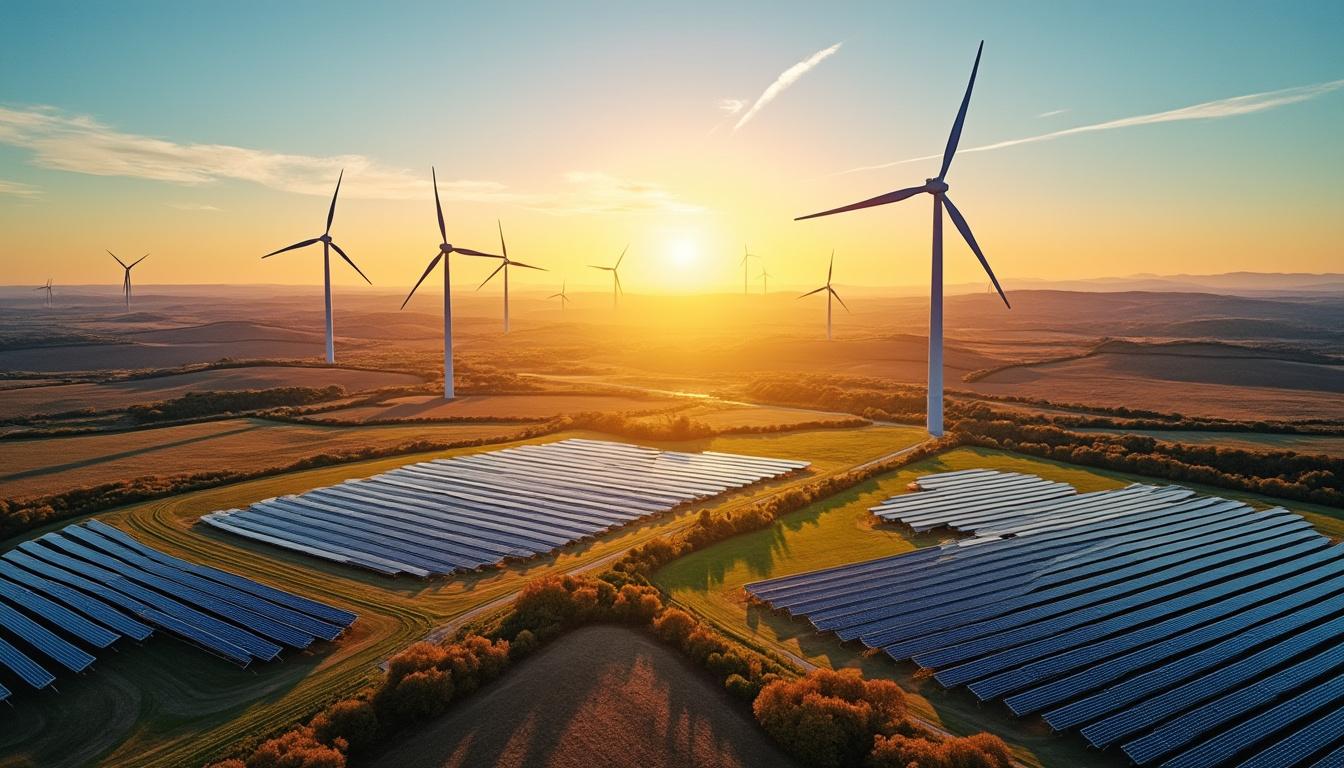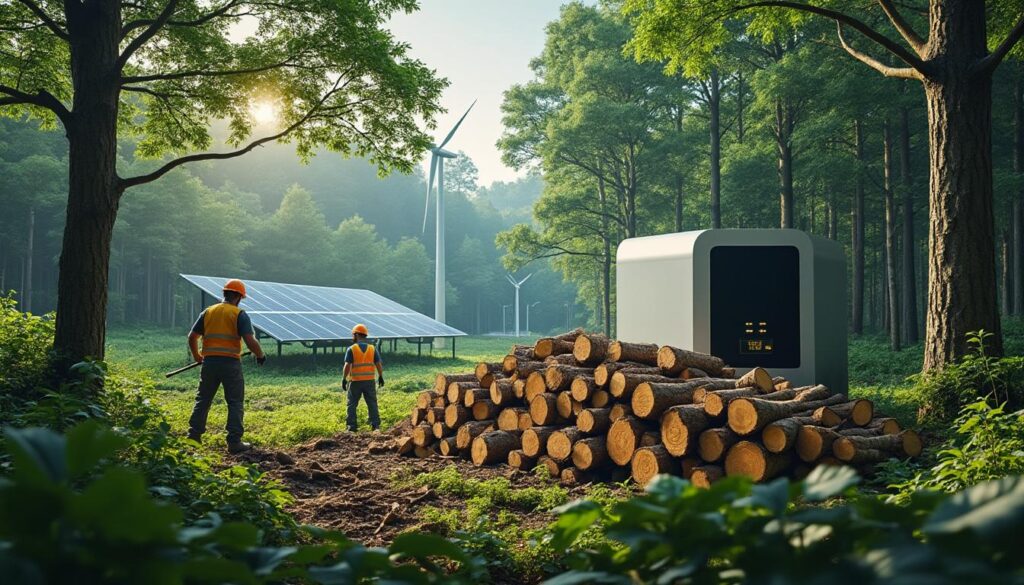The announcement of new development and acceleration zones for renewable energies arrives at a decisive moment for the energy transition in Portugal. In parallel, expectations are set for clearer, faster, and more balanced processes with the territory.
This practical guide explains how these zones work, what changes in licensing, and how companies, municipalities, and families can benefit — from the “Green Map” to digitization, addressing biodiversity, biomass, and network security.
| Short on time? Here’s the essential: | |
|---|---|
| ✅ Key Point | 🔎 Detail |
| ✅ Acceleration zones 🌱 | “Go-to areas” with lower sensitivity and more agile licensing, guided by a Green Map indicating where to invest with predictability. |
| ✅ Grid connection ⚡ | A new decree-law promises more predictability and transparent queues where demand is higher. |
| ✅ Less bureaucracy 🧭 | Digitization, defined deadlines, and coordination between entities to reduce the avalanche of paperwork. |
| ✅ Local communities 🤝 | Sharing of benefits, social acceptance, and safeguarding of biodiversity for more solid and lasting projects. |
| ✅ Industry and biofuels 🏭 | Centers for biomass recovery, support for energy-intensive industries, and fleets with 100% renewable fuel. |
Acceleration zones: Government boosts development for renewable energies with “Green Map”
The acceleration zones concentrate investment where the environmental and heritage impact is lower and the electrical network can receive new production efficiently. Inspired by REPowerEU, these areas — often referred to as “go-to areas” — are identified with the technical support of the LNEG and cross data on ecological sensitivity, network connectivity, and land use.
The future “Green Map” serves as a compass for promoters, municipalities, and citizens: it avoids conflicts, reduces uncertainties, and signals where licensing can be accelerated. In 2025, this tool began to be prepared to encompass solar, wind, and hybrid projects, paving the way for more predictable initiatives.
How to identify areas with a higher likelihood of advancement
The criterion is objective: lower environmental sensitivity, distance from critical habitats, existing accesses, and available network capacity. Example? In the Baixo Alentejo territories, areas with low agricultural suitability and optimal solar radiation combine with transport corridors, favoring photovoltaic installations.
To illustrate, imagine the Cooperativa Vale Claro, in an interior parish: by choosing an area classified as preferential, it reduces the licensing cycle, integrates panels with agrivoltaic (controlled shade for resilient crops), and reserves a fund for local benefits. Result: solid project, faster, and with social adherence.
- 🌍 Prioritize low sensitivity areas according to the Green Map to reduce risks of delays.
- ⚡ Check proximity to substations and network capacity to avoid reinforcement costs.
- 🧩 Consider hybrid solutions (solar + wind) to maximize firm capacity in less area.
- 🤝 Negotiate early with the municipality and neighbors to structure benefits sharing.
| 🛠️ Measure | 🔁 Practical Impact | 👥 For whom |
|---|---|---|
| Definition of “go-to areas” | Fewer conflicts and faster licenses | Promoters, municipalities |
| Green Map | Clear signaling of preferred zones | Companies, citizens, investors |
| Environmental criteria | Compatibility with biodiversity and landscape | Local communities |
| Network planning | More predictable connections | Network operators |
Want to advance with confidence? First, choose the right place: it’s half the journey to a viable project.

Predictable licensing and grid connection: how the new rules unlock projects
The Government announced a new decree-law to provide more predictability to the requests for grid connection in areas of higher demand. In practice, this means transparent queues, objective criteria, and advance communication of capacity windows.
During the Portugal Renewable Energy Summit, the topic was clear: there are too many entities in licensing and an excess of regulations that hinder decisions. The answer lies in digitization, strengthening technical teams, and integrating opinions at a single counter.
Step-by-step to reduce downtime
Start by submitting the implementation study with updated maps from the Green Map. Then, align the request for grid connection with the reinforcement cycles announced by the operator. Finally, anticipate environmental measures — biologists, noise, landscape — in the very project base.
When this happens, the project reaches the public teams with fewer gaps, lowering the chance of additional element requests and avoiding back-and-forth that consumes months.
- 🗂️ Use a digital checklist with all necessary opinions.
- 📡 Schedule technical meetings before submission to align expectations.
- 🔌 Check available capacity and network reinforcement deadlines.
- ⏱️ Estimate realistic buffers and communicate them to the investor and the community.
| 🚧 Bottleneck | 🧩 Solution | 🏁 Benefit |
|---|---|---|
| Multiple opinions | Single counter and standard deadlines | Reduction of delays 📉 |
| Opaque queue in the grid | Transparency and public calendar | Predictability ⚖️ |
| Incomplete dossiers | Digital checklist with validation | Less rework 🧠 |
| Excess paperwork | Electronic submission and interoperable | Decision pace 🚀 |
Licensing well is good project design: the more solid the dossier, the faster the authorization appears.
Biodiversity, social acceptance, and benefit sharing: the triangle that supports development zones
As acceleration happens, more environmental and social quality is demanded. The message that echoed in the sector is clear: winning projects integrate from the beginning biodiversity safeguards and mechanisms for benefit sharing with communities.
What safeguards make a difference? Ecological corridors, construction periods adjusted to nesting seasons, acoustic monitoring in wind farms, and landscape design in large photovoltaic projects. In parallel, transparent communication and tangible benefits reinforce social acceptance.
Tools to align territory and technology
Start with a serious ecological diagnosis. Then, define a communication plan: open meetings, 3D visualizations, and visits to reference projects. Finally, offer a benefits package with clear rules: community fund, energy discounts, internships, and local training.
Practical example: in a coastal municipality, a wind farm agreed on an energy efficiency program for public buildings and finances the installation of energy communities in neighboring neighborhoods. Result: more comfort, lower bills, and immediate climate impact.
- 🦋 Integrate biodiversity-friendly measures into the base project.
- 📣 Schedule public sessions with simple and objective materials.
- 💶 Create a local fund to support schools, health, and energy rehabilitation.
- 🔄 Encourage collective self-consumption and social energy tariffs.
| 🌿 Safeguard measure | 🔧 Application | 📌 Example |
|---|---|---|
| Ecological corridors | Delimitation and monitoring | Wildlife crossings 🦊 |
| Environmental calendar | Work outside nesting | Minimizes impacts 🐦 |
| Benefits plan | Fund and fair-priced energy | Neighboring communities 🤝 |
| Landscape design | Visual integration | Less conflict 👀 |
When the territory wins, the project wins: that’s the new rule of the game.
Industry, biomass, and sustainable fuels: where the best opportunities lie
The development zones for renewables do not only serve large plants. They open doors to forestry biomass with local valorization, advanced biofuels for transportation, and solutions for energy-intensive industries to become more competitive in a demanding carbon market.
Portugal received European authorization to strengthen support for energy-intensive companies, compensating carbon costs and encouraging long-term contracts with renewable energy. Meanwhile, fleets operating with 100% renewable fuel show that the transition is already on the roads.
From field to factory: short chains and local value
Biomass recovery centers reduce fire risk, create jobs, and feed high-efficiency boilers for industrial heat. In heavy and maritime transport, HVO and biomethane blends gain ground, especially when integrated into logistics zones near the “go-to areas.”
For municipalities, combining energy communities with biomass boilers for public equipment can measurably reduce bills and emissions. For industry, PPA contracts with parks in acceleration zones ensure a stable price and certified renewable origin.
- 🔥 Evaluate local forest residues for industrial and district heating.
- 🚛 Test biodiesel in municipal or logistics fleets.
- 📄 Consider renewable PPAs to stabilize energy costs.
- 🏫 Connect schools and hospitals to community energy projects.
| 🏭 Sector | 🌐 Opportunity | 📈 Indicator 2025 |
|---|---|---|
| Energy-intensive industry | Compensation for carbon costs and PPAs | Strengthened support package 💶 |
| Transport | Fleets with 100% renewable (HVO/biomethane) | Scaling pilots 🚚 |
| Biomass | Recovery centers with forestry management | More regional projects 🌲 |
| Public services | Renewable heat + energy communities | Lower bills 🧾 |
The best project is the one that connects local resources to real needs, with benefits that stay in the region.
Electrical grid, storage, and cybersecurity: preparing the system to scale with confidence
Without a grid there is no transition. Strengthening connection points tailored to the territory is crucial, just like new solutions for storage and demand management. Leading companies have already highlighted the need to bolster cybersecurity against new threats.
The path includes utility-scale batteries, distributed storage in buildings, and integration of AI-driven forecasting algorithms to balance generation and consumption. In variability scenarios, microgrids and demand response help stabilize operations.
From rooftop to substation: layers of resilience
In buildings, the trio insulation + photovoltaics + batteries reduces peaks and increases autonomy. On the grid, hybrid projects and advanced control systems enhance firm capacity. At the cyber level, continuity plans and team training become as important as inverters and cables.
Concrete example: a hybrid wind-solar park with on-site storage manages to meet delivery ramps, improve predictability, and reduce curtailment. For the grid operator, this translates into less deviation and more security.
- 🔋 Consider storage in new and repowering projects.
- 📶 Explore demand response in industries with flexible loads.
- 🛡️ Invest in cybersecurity and business continuity.
- 🛰️ Use AI for real-time production and consumption forecasting.
| ⚙️ Technical solution | 🗓️ When to use | 🧪 Tool/Example |
|---|---|---|
| Utility batteries | In areas with peaks and congestion | Hybrid wind-solar 🔁 |
| Microgrids | Industrial parks and hospitals | Local management with EMS 🧠 |
| Demand response | Flexible industrial processes | Contracts with aggregators 📜 |
| Security and AI | 24/7 operations and telemetry | SIEM + forecasting with AI 🔐 |
Resilience is planning: each layer reduces risks and accelerates renewable integration.
How citizens and municipalities can act now in the new development zones
The acceleration zones bring concrete opportunities for families, municipalities, and SMEs. The key is to connect human-scale projects with the territorial advantages of the Green Map and the predictability of the new regulation.
Municipalities can prepare local energy letters, mapping public rooftops, compatible lands, and energy communities by neighborhood. Citizens can organize self-consumption consortia, leveraging school or pavilion rooftops. SMEs can combine photovoltaics + batteries with flexible energy contracts.
Action plan in 30-60-90 days
30 days: identify preferred areas and partners. 60 days: consult network operators and design the environmental and community package. 90 days: submit the complete digital dossier and schedule public clarification sessions. A simple but effective roadmap to gain traction.
If you seek inspiration, follow real cases in the national ecosystem and use knowledge-sharing platforms dedicated to sustainable habitat and efficiency; you’ll find replicable good practices, from energy rehabilitation to smart management.
- 🧭 Form a local group (municipality, IPSS, schools, SMEs, neighbors).
- 🏗️ List available rooftops and lands based on the Green Map.
- 📑 Prepare a specification document that is simple and objective.
- 🗣️ Schedule a public session with visuals and transparent costs.
| 🪜 Step | ⏱️ Deadline | 🎯 Expected outcome |
|---|---|---|
| Mapping | 0–30 days | List of priority locations 📍 |
| Engagement | 30–60 days | Partnerships and local support 🤝 |
| Submission | 60–90 days | Complete digital dossier 💻 |
| Implementation | 90+ days | Phased and monitored work 🧰 |
Simple action for today: choose a public or business rooftop and check, based on the Green Map, if it is in a preferred zone. The first step is always the shortest — and the one that counts the most.
Source: expresso.pt


